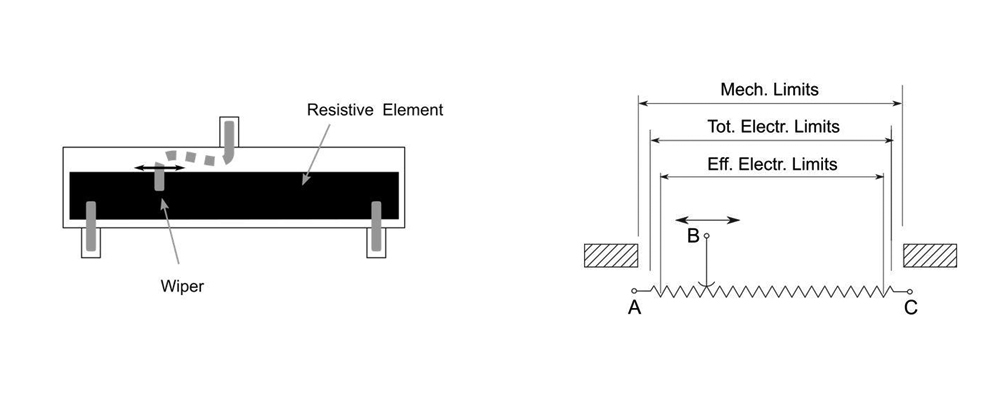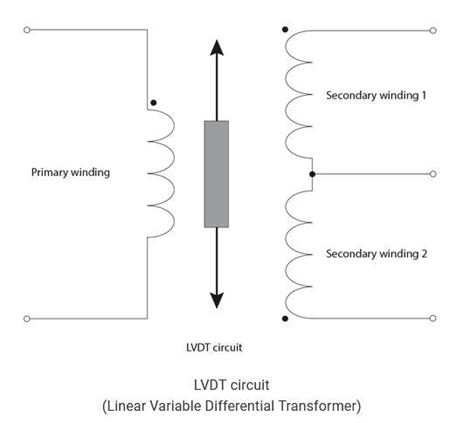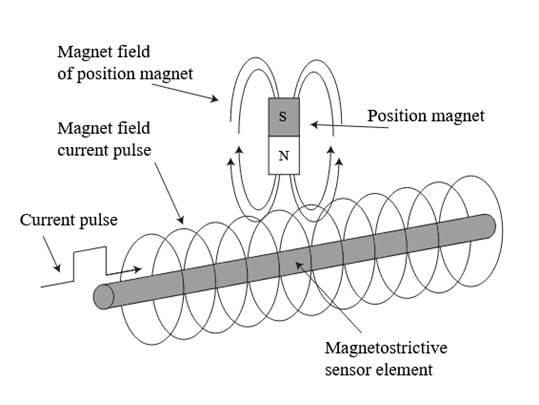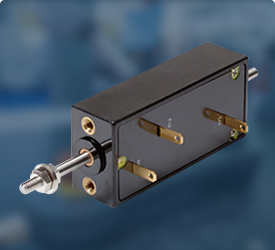Types of Linear Motion Transducers
Linear displacement transducers (linear sensors) are available in five different measurement principles:
- Linear potentiometer
- Inductive (LVDT)
- Magnetostrictive
- Draw Wire Sensors (Cable Transducer, String pots)

Linear Motion Potentiometers
Linear potentiometers are passive components utilizing conductive plastic or wire-wound resistive elements in specific lengths (2mm up to 2000mm). The wiper (slider) is moved over the resistance element providing a linear change in output voltage relative to the measuring length. Linear potentiometers are types of linear transducers with three connections: two for the resistor ends and one for the wiper (slider).
- Simple sensor principle, mostly without electronics
- Measured value is instantaneous and absolute
- Resolution is essentially infinite
- Economical and available in a wide variety of styles
- Works with low voltages (minimal power consumption)
- Insensitive to magnetic interference fields
We have a wide range of linear motion potentiometers with a standard IP65 rating and some IP67 options.
Outputs of Linear Motion Potentiometers
Linear potentiometers provide an analog voltage output varying from 0 volts up to the applied voltage. Assuming 10V is applied, the output would be 0 - 10V over the stroke length. With 5V applied, the output is 0 - 5V.
Some of the models have a built-in signal conditioner that can provide either a 0 - 10V output or a 4 - 20mA output. In this case, the required supply voltage must be 15V - 30V.

Linear Variable Displacement Transducers (LVDT)
The LVDT is an absolute analog position sensor that is based on inductive technology consisting of a primary coil and two secondary coils. These coils convert the motion of the shaft as a linear transducer into electrical signals that can be processed for accurate control and measurement. Being inductive, the sliding wiper used with potentiometers is not required, and thus, is wear-free.
- Sealed sensor (high IP protection)
- High precision linearity
- Able to measure micro displacements
- Near infinite resolution
- Durable, consistent accuracy
- Maintenance and wear-free
- Suitable for high dynamics
- Reproducible zero point
- Absolute signal output
- Insensitive to many chemicals
Our LVDT range of products are rated at IP65 with IP67 options.
Outputs of Linear Variable Displacement Transducer (LVDT)
The LVDT native output is in mV/V requiring external signal conditioning to provide an analog voltage or milli-amp output.
Some of the models have a built-in signal conditioner capable of either voltage or milli-amp outputs.

Magnetostrictive Linear Sensors
Magnetostrictive linear sensors, also known as analog magnetostrictive linear transducers, are robust, absolute measuring systems with a resolution of up to 2 µm. The measured values are made without contact, so the sensor has an unlimited life and is wear and maintenance-free. The sensor consists of a robust housing, a waveguide inside, an external sliding magnet (donut cursor) that deflects the generated pulses, and a converter that converts the returning vibrations into an electrical signal. The position of the magnet is then determined by magnetostriction.
- Sealed sensor (high IP protection) with electronics
- Contactless measuring principle
- Maintenance- and wear-free
- Durable, consistent accuracy
- Long measuring distances up to 4000 mm
- Insensitive to shock and vibration
- Withstands high pressures - ideal for hydraulically moved axes
- Insensitive to many chemical media
The Magnetostrictive range of position sensors are rated at IP65 with IP67 options.
Outputs of Magnetostrictive Linear Sensors
Analog magnetostrictive linear transducers are available with 0-10V, 10-0V, 0-20 mA, 20-0 mA, 4-20 mA, and 20-4 mA outputs. The supply voltage is 24VDC.
Digital magnetostrictive position sensors are provided with a Profinet or Profibus interface.

Draw Wire Sensors
These linear transducers are commonly referred to as cable transducers or string potentiometers (string pots). The key component of a draw wire sensor is a highly flexible steel wire rope that is wound single-layered on an ultra-light capstan. This capstan is connected to the sensor housing by a pre-stressed spring. The end of the steel wire rope is equipped with a clip that gets connected to the target object. As soon as the distance between the sensor and the target object changes, the steel wire rope gets pulled out of the sensor and is rolled off the capstan (or vice versa). The shaft of the capstan is connected to a precision potentiometer (for analog output signals), or to an encoder (for digital output signals). If there is a rotation of the capstan due to a change in the distance to the target object, the sensor element will turn proportionally. This way the potentiometer, or the encoder converts a linear movement into a proportional electrical signal.
- Measurement ranges from 50 mm up to 50000 mm
- High dynamics: travel speed up to 10 m/s
- Durable, consistent accuracy
- Specialized for mobile hydraulic applications
- Protection class up to IP69k
- Easy mounting
- Operating Temperature -20...+85 °C (optional -40 °C or +120 °C)
- Can be mounted remotely from the target to be measured
The majority of draw wire sensor models are rated at IP65 with IP67 and IP69K options.
Outputs of Draw Wire Sensors
Analog output options include 0...5 V, 0...10 V, and 4...20 mA.
Digital output options include TTL, HTL, SSI, Profibus, CANopen, EtherCAT, and Profinet.
Contact P3 America
P3 America has been a leading provider of economical sensors, linear motion transducers, and positioning products. Our extensive product selection allows us to address your needs promptly and effectively. With some of the best delivery times in the industry, we can help your operation to continue running smoothly and help your bottom line grow.
For more information on our products and services, contact us today.
Call Now: (858) 277-1420
Or Email:
sales@p3america.com





